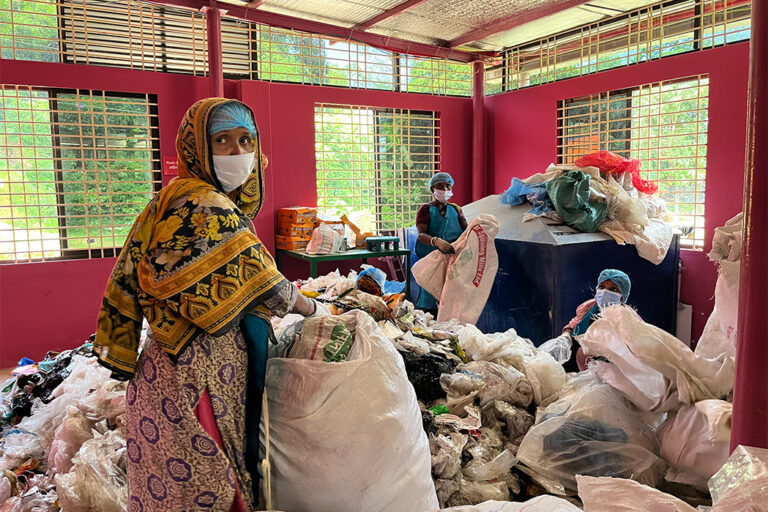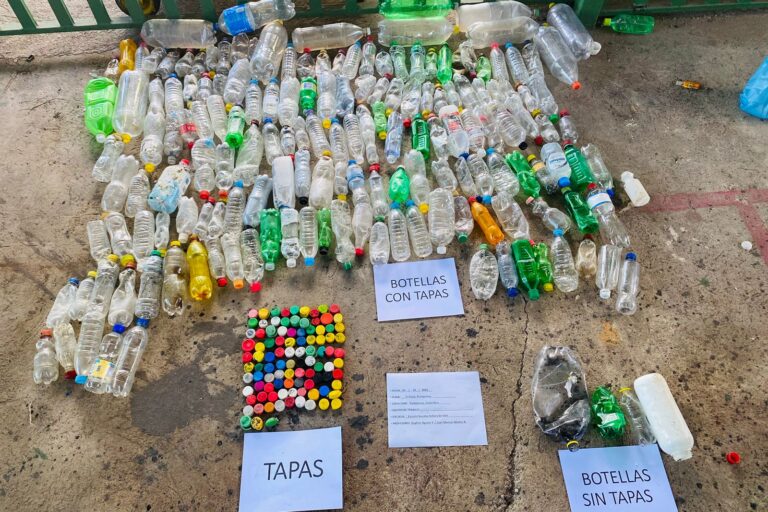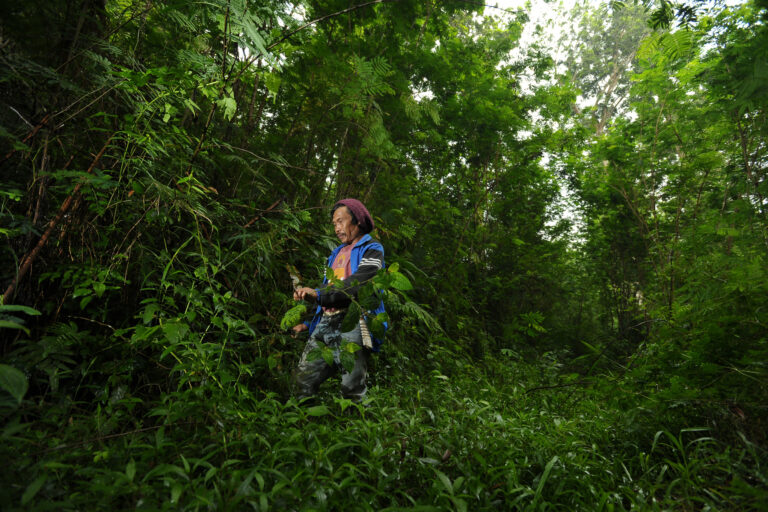- In 2010, the Philippines’ Supreme Court set the provisions for what it calls the “Writ of Kalikasan,” a landmark legal remedy that compels the government to act and halt environmental degradation that impacts more than one municipality.
- More than a decade since it was first defined and used in court, the writ has been invoked for various cases, from closing open dumpsites and illegal landfills, to prompting the government to protect important bodies of water like the rehabilitation of Manila Bay.
- While many petitions have been approved this way, the rulings haven’t always been implemented by local governments.
- In 2019, fishers deprived of access to a fishing site in a part of the South China Sea claimed by Beijing filed a petition for Writ of Kalikasan; however, they backed out of the case soon after, citing a lack of understanding of the legal complexities.
Filipino fishers call it the “secret island” — a group of three sandbars that emerge when the tide’s low enough, located a mile or so away from Pag-asa Island, known outside the Philippines as Thitu.
They go there because it’s teeming with fish. But since 2017, the area has been largely inaccessible due to an international maritime dispute over parts of the South China Sea: Pag-asa, which is 390 kilometers (240 miles) northwest of the Philippine province of Palawan, is one of the areas to which China has staked a claim.
The Philippines has successfully challenged China’s claim, lodging a case at a U.N. tribunal and winning recognition of its sovereignty over Pag-asa in 2016. China, however, has refused to recognize the tribunal’s jurisdiction and insists on addressing the maritime dispute bilaterally.
Even after the ruling was handed down, the fishers have still been unable to access the secret island, they say, with the Chinese Coast Guard blocking their access to the sandbar since 2017.
“We cannot fish there anymore, it’s forbidden, already forbidden,” Robert Asiado, president of the local fishers’ group, told Mongabay.
The National Task Force–West Philippine Sea (NTF-WPS), a government body created in 2016 to enforce maritime security in the areas that fall within the Philippine’s exclusive economic zone, alleges that Chinese vessels have wreaked havoc on the area, harvesting protected species including coral, giant clams, and sea turtles.
Asiado is one of 37 fishers who signed a petition for “Writ of Kalikasan” on April 2019. It’s an attempt to use a unique legal mechanism to force the Philippine government to take action to ensure that national environmental protection laws are enforced in the area. By August 2019, four months later, Asiado and 17 other fishers asked for the case to be withdrawn, highlighting the complexity and limitations of this legal remedy.

A matter of trust
Since 2010, Filipinos have had a distinctive legal weapon: the Writ of Kalikasan (nature) is based on the constitutional mandate for the state to “protect and advance the right of the people to a balanced and healthful ecology.” Created by the Supreme Court, the writ can be invoked in cases where this constitutional right is violated by “environmental damage of such magnitude as to prejudice the life, health or property of inhabitants.”
In the subsequent decade, attempts to use the Writ of Kalikasan to force a government response have yielded both high-profile successes and failures.
In the case concerning disputed territories in the South China Sea, including Pag-asa Island, fishers from the provinces of Palawan and Zambales filed a petition for a Writ of Kalikasan on April 16, 2019. Jose Manuel “Chel” Diokno from the Integrated Bar of the Philippines (IBP), the official organization of lawyers in the country, represented them.
The petition called on the Supreme Court to order government agencies overseeing the protection of environment, fisheries and aquatic resources — the Philippine Navy, Coast Guard, national police force, its maritime division, and the Department of Justice — to implement Philippine laws in areas that are part of the Philippines’ exclusive economic zone but whose ownership is being disputed by China in the South China Sea: Scarborough Shoal, Second Thomas Shoal, and Mischief Reef.
The petition alleged that government agencies had failed to prevent Chinese vessels from harvesting coral, giant claims and sea turtles within the Philippines’ EEZ, thereby failing to carry out their obligations under the CITES wildlife trade convention; the Philippine Fisheries Code; and Presidential Decree No. 1586, which requires environmental impact statements.
Petitioners said their “constitutional right was violated by environmental crimes committed by foreigners in 2012 and 2013 that resulted to massive destruction … Their constitutional right continues to be violated by Public Respondents’ failure, if not refusal, to vindicate the Petitioner’s constitutional right by prosecuting the foreigners who committed the crimes.”
The High Court issued a Writ of Kalikasan on May 3, 2019, which meant the petition was found to be sufficient in form and substance, and scheduled oral arguments on July 2 and 9, where both parties presented their case.
This petition had the potential to be a landmark case, said Antonio La Viña, an environmental lawyer not involved in the case. “It would be a landmark ruling because it would be finding that the executive branch was not doing its job to implement Philippine fisheries environmental law in the West Philippine Sea,” La Viña said. “Depending on how prescriptive the SC [Supreme Court] decision is, it could also be a victory of judicial activism versus the conventional view that foreign policy and national security are the exclusive domain of the executive branch.”
Then, on July 9, Solicitor General Jose Calida dropped a bombshell: he said the petitioners had withdrawn their signatures and submitted affidavits saying they didn’t know anything about the petition for the Writ of Kalikasan nor did they support it.
“These statements show deception,” Calida said. “The IBP lawyers involved in this case foisted egregious deceit not only on the fisherfolk but also on the honorable court.”
Asiado and Abogado, another officer of the Kalayaan Palawan Farmers and Fisherfolk Association, alleged that the lawyers did not fully inform them about the nature of the petition they were signing.
“We were so confused because we’re not really well-educated, this was the first time this happened to us, it became so messy, it was like a nylon, everything was tied up, you cannot uncoil it,” Asiado said. “That was where the problem totally came from, they were able to explain what the petition for the writ is but we didn’t know that the impact on us will be that big.
“They signed immediately because they did not understand what it was about — they thought it was aid from the Bureau of Fisheries and Aquatic Resources,” Asiado added, referring to the government agency that oversees the management and protection of marine resources.

Diokno, the lead lawyer on the case, did not respond to several requests for comment.
Legal experts not affiliated with the case note that marginalized communities, such as fishers, are vulnerable to pressure from outside forces, such as the government, and that lawyers need to work carefully to build ties and trust with petitioners.
“Without second-guessing the IBP lawyers or judging the fisherfolk as I truly understand them, clearly the lesson here is to try to find petitioners that are not vulnerable to such pressure,” La Viña said. “That means the lawyers must have a strong relationship with such petitioners established over years of struggle.”
To succeed, cases like this require lawyers “fully vetting the prospective complaining parties and ensuring their full commitment to the case by insulating them from external influences,” said maritime law expert Jay Batongbacal. “I think the problem here is that the petitioner-fishermen were quite vulnerable to government pressure due to their respective situations. Future petitioners have to be selected very carefully, and must be sure of pursuing their cases to the very end.”
Other cases
Previous petitions for Writs of Kalikasan that did progress showed what the writ can do, from seeking damages to stopping projects that can potentially damage the environment.
One of the highest-profile attempts to use the Writ of Kalikasan came in 2014, after a U.S. Navy ship, the USS Guardian, ran aground on the Tubbataha Reefs, a natural park and UNESCO World Heritage Site.
A group that included environmentalists, bishops and other notable figures filed a petition against then-president Benigno Aquino III and three U.S. military officials, seeking 58 million pesos, or around $1.9 million from the U.S. as compensation for the damages.
The Supreme Court dismissed the petition because it was considered a case against the U.S. itself, and states are shielded from lawsuits under the principle of sovereign immunity. However, the Philippine Department of Foreign Affairs later raised the demand for compensation with its U.S. counterpart. In 2015, the U.S. paid the Philippines $2 million for the damages.
There were other clear victories.
In March 2018, the Supreme Court upheld a 2017 ruling by the Court of Appeals that granted a Writ of Kalikasan sought by then-city councilor Joel Capili Garganera, who filed it on behalf of the cities of Cebu and Talisay and “future generations.” Garganera had asked that then-mayor Tomas Osmeña stop the operations of the Inayawan landfill, which the Department of Health said fell short of sanitary requirements. The Supreme Court ruled in Garganera’s favor and ordered the landfill’s permanent closure.
In 2013, the Court of Appeals also ordered the closure and rehabilitation of an open dumpsite in the northern province of Bontoc after the Kalinga Anti-Pollution Action Group filed a Writ of Kalikasan saying the waste had polluted irrigation water.
However, even when a Writ of Kalikasan is granted, the verdict is not always implemented. For example, a 2012 verdict by an appeals court ordered the permanent closure of the Irisan dumpsite in Baguio City. Typhoon Nanmadol had caused a trash slide at the dumpsite in 2011, killing five people. Despite the verdict, operations at the dumpsite continued six years later. It was eventually closed, however, and was turned into an ecological park.
Several petitions for Writ of Kalikasan have also been rejected. In April 2018, the Supreme Court denied a petition filed by Ang Aroroy ay Alagaan Inc., an NGO, against the mining company Filminera Resources Corp. The court found no merit in the petitioners’ argument that the company’s operations had destroyed the environment in the province of Masbate.
In 2017, the court also rejected a Writ of Kalikasan petition asking government officials to adopt a road-sharing policy, where half the road is allocated for motor vehicles and the other half for bicycles and trams. The Supreme Court said the petitioners had presented insufficient evidence that a failure to designate a portion of the road for bike lanes would violate their right to a balanced and healthful ecology.
In May 2015, the Supreme Court overturned a 2013 decision by a lower court that granted a Writ of Kalikasan filed against Redondo Peninsula Energy for its planned construction of a 600-megawatt coal-fired power plant. The court said the petitioners had failed to prove that the project carries health risk, thereby paving the way for the plant’s construction.
For the future
In the case of the fishers in Palawan, despite the failure of the lawsuit, the general sentiment is that the government has already stepped up in coming to their aid against Chinese authorities and even fishers from other countries.
“There’s been 70% improvement, the patrol ships of China don’t stay as much as they do so in Pag-asa,” Abogado said.

But despite this improvement and his withdrawal from the 2019 case, Abogado said local fishers are not ruling out filing another petition of the Writ of Kalikasan, provided they are consulted extensively and as a group next time.
He said that, more than ever, the filing of such a petition would benefit those who will come after them.
“It will not only be for this generation, but for the one succeeding us,” Abogado said, “because the ocean will still be there.”
Additional research by Keith Fabro in Palawan.
Related stories:
Banner image of a hawksbill sea turtle by Shawn Landersz via Flickr.
FEEDBACK: Use this form to send a message to the author of this post. If you want to post a public comment, you can do that at the bottom of the page.













